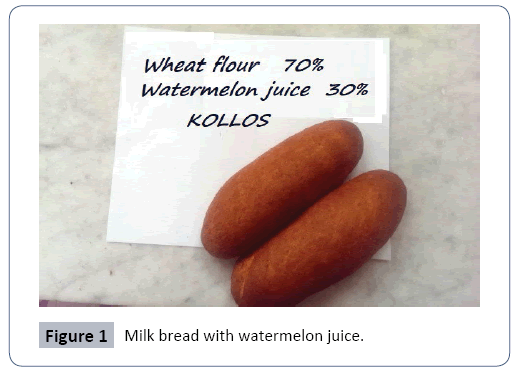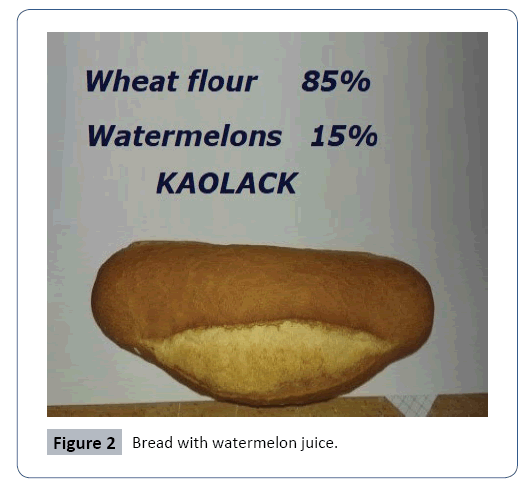Mamadou Sadji1, Ndèye Fatou Ndiaye1, Maurice S Lopy1, Cheikna Zongo2, Yves Traore2, Mohamadou Diop Sall3* and Alfred Traore2
1Institute of Food Technology, Hann, Dakar, Senegal
2Centre of Research in Biological Sciences Food and Nutrition, University of Ouagadougou, Ouagadougou, Burkina Faso
3Superior Polytechnic School, Cheikh Anta Diop University, BP 5085, Dakar-Fann, Senegal
*Corresponding Author:
Sall MD
Superior Polytechnic School
Cheikh Anta Diop University
BP 5085, Dakar-Fann, Senegal
Tel: +221 33 825 05 30
E-mail: msmdsall@gmail.com
Received Date: January 01, 2018; Accepted Date: March 05, 2018; Published Date: March 10, 2018
Citation: Sadji M, Ndiaye NF, Maurice S Lopy, Zongo C, Traore Y, et al. (2018) Production of Puree and Watermelon (Citrullus lanatus) Juice Usable in Bread Making. J Food Nutr Popul Health Vol.2 No.1:1
Background and Justification
The "watermelon sector" in the Sahelian countries is characterized by a double burden because not only a large quantity of the production is lost but the upgrading technologies are non-existent. The transformation of the watermelon remains the weakest link in the value chain whose interest in populations continues to be important. Indeed, watermelon is mainly used in the raw state that means; its flesh is directly consumed as such or simply transformed into juice. It should be noted that the juices obtained by transformation of the watermelon flesh occasionally occur at the level of households or small businesses that do not very often meet the quality requirements for the international market. Watermelon is rich in L-citrulline and L-arginine, two amino acids that play an important role in human metabolism [1-5]. There is a need to diversify the use of watermelon by creating added value that will benefit all actors of the sector, and consumers.
Different Forms of Watermelon Use
In many countries, watermelons are selected to produce a maximum of large seeds that are considered as food because seeds are extremely rich in protein, carbohydrate and fat. In Egypt the watermelon seeds are eaten roasted, grilled and/or salted.
El Badry et al. [4] used powdered watermelon rinds in bread making. The objective of their study was to investigate the nutritional value of watermelon rinds in terms of dietary fiber, minerals and antioxidants. The results of their study showed that watermelon rinds are a good source of dietary fiber and minerals.
In the United States of America, watermelon is consumed as a snack, in fruit salad for breakfast or drink.
In India, watermelon seeds are also widely used in grilled form or transformed into flour and used in bread making. In China watermelon rinds are widely used in "watermelon frost", a therapeutic powder for the treatment of respiratory diseases.
Production of Puree and Watermelon Juice
Objective of the process
The objective of this work is to investigate the processing quality of watermelon in bread making.
Steps and procedure of puree and watermelon juice production
Plant material: Watermelon (Citrullus lanatus) should be chosen according to the maturity criteria which are basically the heaviness and the sound of the fruit after tapping. The fruit should not be affected by any diseases.
Materials and methods/watermelon treatment: First, watermelon must be cleaned and completely hollowed, all components of the fruit (flesh, peels, juice, and seeds) except rinds collected. Flesh can be cut into small pieces to facilitate grinding. After two to three minutes of grinding, a red watermelon solution consisting of a mixture of juice, flesh and seeds is obtained. The grinding can be repeated twice to three times. The watermelon solution is filtered in order to separate watermelon juice and puree. Filtration can be carried out using a sieve (ASTM-E11 Prüf- Sieb) with an opening diameter of three mm and allowing only the watermelon solution to pass through. The volume of mixture obtained depends on the variety, the degree of maturation, the size and the weight of the watermelon. A watermelon of three kilos can contain up to two liters (Figures 1 and 2).

Figure 1: Milk bread with watermelon juice.

Figure 2: Bread with watermelon juice.
Packing and conservation: Puree and watermelon juice can be stored in a cold place (at 6°C) or frozen at -25°C. Quality packaging must be performed, black packaging in 60 μm thick high density polyethylene (HDPE) bags designed to resist tearing and moisture can be used [5-9].
Advantages of the Production Process of Puree and Watermelon Juice for Bread Making
This new technical approach of using watermelon in bread making brings nutrients, improves the protein nutritional quality of breads.
The bread making tests showed that mixture of wheat flour (85%, 70%), with “Kaolack” or “Koloss” watermelon puree or juice (15%, 30%) presented good results [10]. In addition, the innovation here is that, the process allows using watermelon that contains 93% of water [5], instead of using running water.
The incorporation of watermelon puree or juice in wheat flour has some advantages in bread making:
• The reduction of running water used to hydrate the bread dough
• The reduction of wheat flour when watermelon puree is incorporated
• Watermelon puree and juice enhance the palatability of breads more than running water does
• The increase of nutrients such as vitamins, minerals, lycopene, L-citrulline and L-arginine in breads. Incorporation of lycopene into food products presents a health and nutritional interest due in recent years to the various studies showing its functional capacity to reduce the risk of many pathologies such as prostate cancer, colorectal cancer [2,11,12].
References
- Bahr
- i S, Zerrouk N, Aussel C, Moinard C, Crenn P, et al. (2013) Citrulline: from metabolism to therapeutic use. Nutrition 29: 479-484.
- Burton-Freeman B, Sesso HD (2014) Whole Food versus Supplement: Comparing the Clinical Evidence of Tomato Intake and Lycopene supplementation on Cardiovascular Risk Factors. Adv Nutr 5: 457-485.
- Crenn P, De Truchis P, Neveux N, Galperine T, Cynober L, et al. (2009) Plasma citrulline is a biomarker of enterocyte mass and an indicator of parenteral nutrition in HIV-infected patients. Am J Clin Nutr 90:587-594.
- El-Badry N, El-Waseif MA, Badr SA, Ali HE (2014) Effect of Addition Watermelon Rind Powder on the Rheological, Physiochemical and Sensory Quality Attributes of Pan Bread. Middle East Journal of Applied Sciences 4: 1051-1046.
- Erhirhie EO, Ekene NE (2013) Medicinal El Badry alues on Citrullus lanatus (Watermelon): Pharmacological Review. International Journal of Research in Pharmaceutical and Biomedical Sciences 4: 1305-1312.
- Kouatchet A, Lebas E (2007)Hyperammonemic encephalopathy due to enzyme deficiency of the urea cycle. Resuscitation 16: 302-309.
- Moinard C, Cynober L (2007) Citrulline: a new player in the control of nitrogen homeostasis. J Nutr 137: 1621S-1625S.
- Rasmusen C, Cynober L, Couderc R (2005) Arginine and statins: relation with the metabolism of nitric oxide and perspectives in the treatment of atherosclerosis.Ann Biol Clin 63: 443-455.
- Rimando AM, Perkins-Veazie PM (2005) Determination of L-citrulline in watermelon rind. J Chromatogr A 1078: 196-200.
- Sadji M. Valorisation de la pastèque Citrullus lanatus) par l'utilisation de ses substances bioactives en Technologie Alimentaire: Intérêts nutritionnels et sanitaire. Thèse de Doctorat en Nutrition Humaine et Technologie Alimentaire, sous la Direction du Prof Alfred S TRAORE, Université Ouaga 1 Prof Joseph Ki-ZERBO, 2017pages 166-167
- Teodoro AJ, Oliveira FL, Martins NB, de Azevedo MG, Martucci RB, et al. (2012) Effect of lycopène on cell viability and cell cycle progression in human cancer cell lines. Cancer Cell Int 12:36.
- Tomasian D, Keaney JF, Vita JA (2000) Antioxidants and the bioactivity of endothelium-derived nitr
- ic oxide. Cardiovascular Research 47: 426-435.



